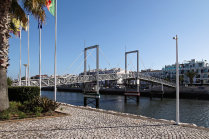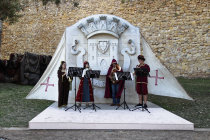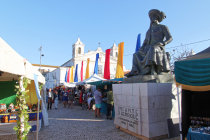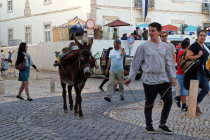
Lagos sits at the secluded mouth of the Rio Bensafrim. The Lucitanians had already an Iron Age hill fort here, ages before first
Phoenician traders arrived and built a settlement in 900 BC.
When the Romans took over they called the town Lagobriga, but under
Moorish rule that changed to Zawaia.
In the early 15th century Lagos became the spearhead for Portuguese expansion in and
colonization of Africa.
Ceuta was captured and colonized, homegrown Gil Eanes sailed beyond Cape Bojadar, Arguim was discovered
and the Cape of Good Hope was rounded, opening the way to Asia.
Lagos also became the gateway for the very profitable African
slave trade.
In 1578 young king Sebastian set sail from here for a crusade against Morocco, only to get himself killed in battle.
The
Lisbon earthquake of 1755 utterly destroyed Lagos and abruptly ended the city's dominant position.
Nowadays Lagos draws scores of tourists
that explore the old town, dot the scenic beaches, indulge in the vibrant nightlife or take a boattour to the nearby Ponta da
Piedade rocks.
We visited Lagos in May 2019.



















nowadays the only slaves on Slavemarket square are animals
Forte da Ponta da Bandeira was built in the 17th century to protect Lagos Harbour
a nicely restored facade
a restored section of the old city wall
a replica of the caravel Boa Esperanca. Ships like this were used in the Age of Discoveries
the statue of king Sebastian I on Praša Gil Eanes square
one of the many small alleys
but this museum is a testimony to the human slave trade on this square
explorer Gil Eannes would have loved a smartphone with GPS


the Ponte Pedonal Levadiša pedestrian drawbridge to the marina




the Avenue of the Discoveries (Av. dos Descobrimentos)









the fort has a small drawbridge









the Igreja de Santa Maria de Lagos was used by king Sebastian to rally his troops





















strongman Salazar did not like the childish representation of the king



the statue for Henry the Navigator, who organized and financed many of the exploration voyages



































































